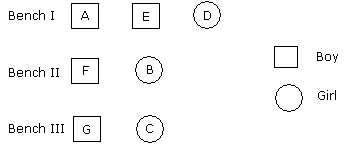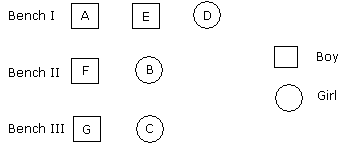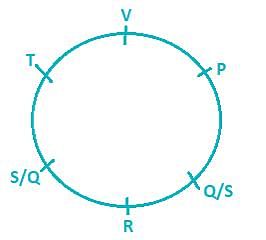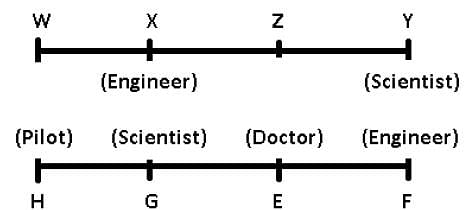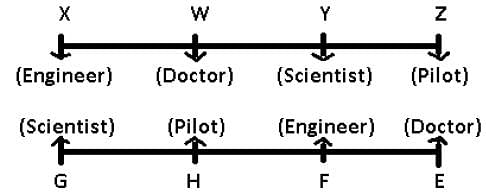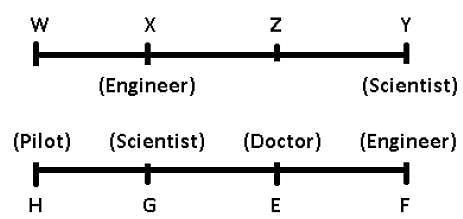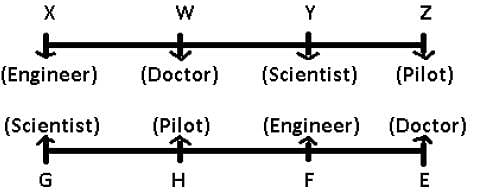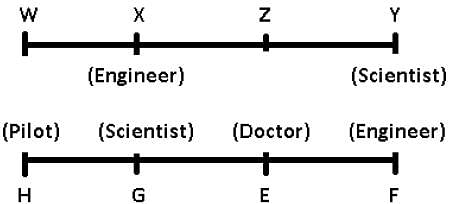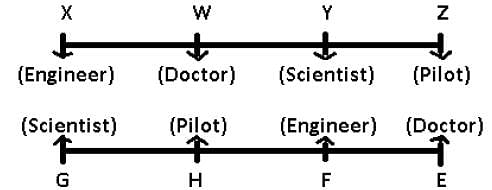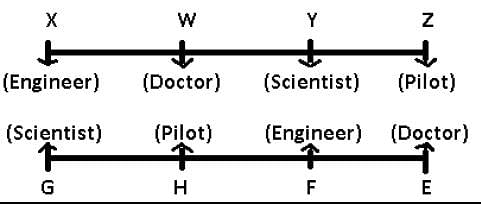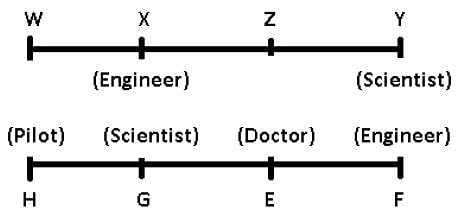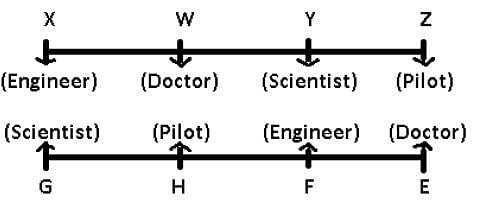Practice Test: Seating Arrangement - 3 - CAT MCQ
15 Questions MCQ Test Logical Reasoning (LR) and Data Interpretation (DI) - Practice Test: Seating Arrangement - 3
Directions to Solve
A, B, C, D, E, F and G are sitting in a row facing North :
- F is to the immediate right of E.
- E is 4th to the right of G.
- C is the neighbour of B and D.
- Person who is third to the left of D is at one of ends.
Question -
Who are to the left of C ?
Directions to Solve
A, B, C, D, E, F and G are sitting in a row facing North :
- F is to the immediate right of E.
- E is 4th to the right of G.
- C is the neighbour of B and D.
- Person who is third to the left of D is at one of ends.
Question -
Which of the following statement is not true ?
| 1 Crore+ students have signed up on EduRev. Have you? Download the App |
Directions to Solve
A, B, C, D, E, F and G are sitting in a row facing North :
- F is to the immediate right of E.
- E is 4th to the right of G.
- C is the neighbour of B and D.
- Person who is third to the left of D is at one of ends.
Question -
Who are the neighbours of B ?
Directions to Solve
A, B, C, D, E, F and G are sitting in a row facing North :
- F is to the immediate right of E.
- E is 4th to the right of G.
- C is the neighbour of B and D.
- Person who is third to the left of D is at one of ends.
Question -
What is the position of A ?
Five friends, Bhumika, Rashi, Shweta, Vibha and Arunima, are sitting in a row facing east. Bhumika is sitting between Vibha and Shweta. Rashi is second to the left of Shweta. Who is sitting at the south end?
Directions to Solve
In a class there are seven students (including boys and girls) A, B, C, D, E, F and G. They sit on three benches I, II and III. Such that at least two students on each bench and at least one girl on each bench. C who is a girl student, does not sit with A, E and D. F the boy student sits with only B. A sits on the bench I with his best friends. G sits on the bench III. E is the brother of C.
Question -
On which bench there are three students ?
Directions to Solve
In a class there are seven students (including boys and girls) A, B, C, D, E, F and G. They sit on three benches I, II and III. Such that at least two students on each bench and at least one girl on each bench. C who is a girl student, does not sit with A, E and D. F the boy student sits with only B. A sits on the bench I with his best friends. G sits on the bench III. E is the brother of C.
Question -
Which of the following is the group of girls ?
Directions to Solve
In a class there are seven students (including boys and girls) A, B, C, D, E, F and G. They sit on three benches I, II and III. Such that at least two students on each bench and at least one girl on each bench. C who is a girl student, does not sit with A, E and D. F the boy student sits with only B. A sits on the bench I with his best friends. G sits on the bench III. E is the brother of C.
Question -
Who sits with C ?
Directions to Solve
Six girls are sitting in a circle facing to the centre of the circle. They are P, Q, R, S, T and V. T is not between Q and S but some other one. P is next to the left of V. R is 4th to the right of P.
Question -
Which of the following statement is not true ?
Directions to Solve
Six girls are sitting in a circle facing to the centre of the circle. They are P, Q, R, S, T and V. T is not between Q and S but some other one. P is next to the left of V. R is 4th to the right of P.
Question -
If P and R interchange their positions then which of the following pair will sit together ?
If Y and X interchange their places, so do H and Z, then who amongst the following will face E?
Which of the given statements is true with respect to the given arrangement?
Which of the following represent both the immediate neighbours of Y?
Who amongst the following sits to the immediate left of Pilot of row-1?
Which of the following represents the people sitting at extreme ends of both the lines?
|
88 videos|119 docs|91 tests
|
|
88 videos|119 docs|91 tests
|







